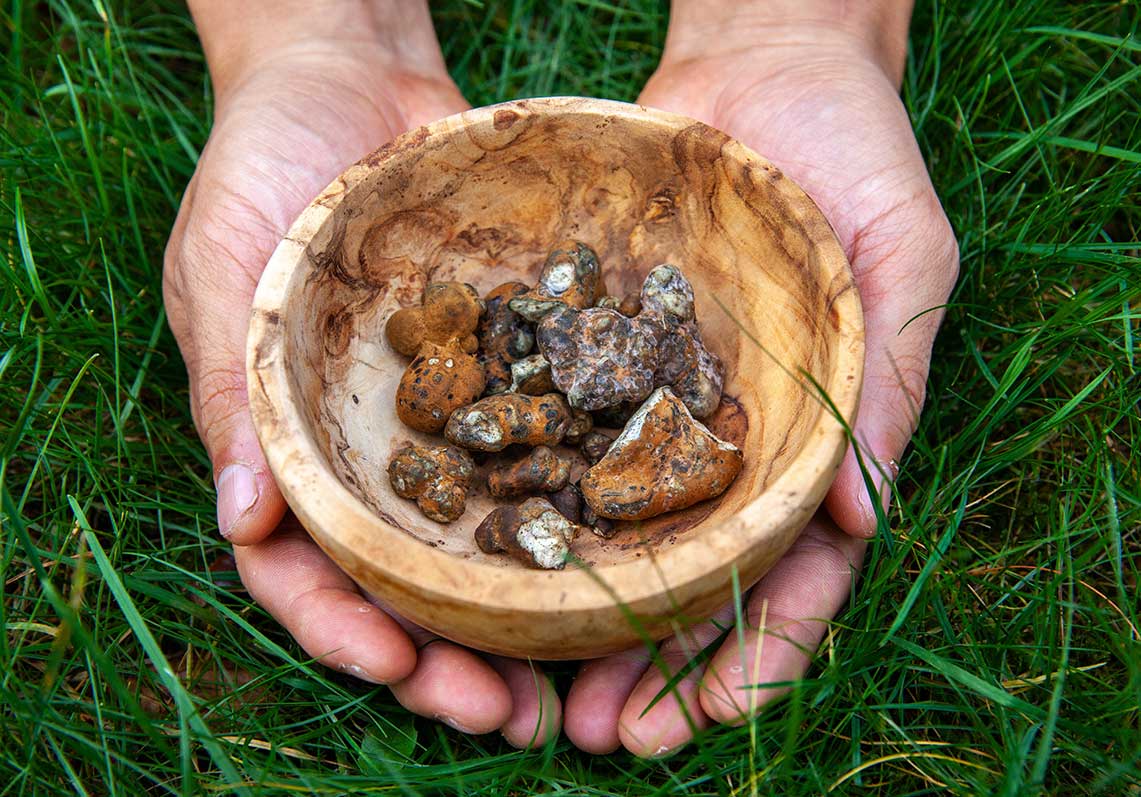Is there a difference between magic mushrooms and psilocybin truffles? It’s a question put to many psychedelic practitioners, as truffles and mushrooms contain similar active compounds and produce similar effects, yet there are big differences in dose, appearance, and even legality.
The subject is often discussed in the Third Wave community, including threads on growing psilocybin mushrooms and blog posts on properly using truffles, but what exactly are the differences?
As a practitioner, this is something you should know.
Quick Definitions: What Are Truffles and Mushrooms?
Psilocybin mushrooms and truffles both belong to the genus known as Psilocybe, but they come from different parts of the organism.
- Psilocybin mushrooms grow above ground and contain high amounts of psilocybin. Known as fruiting bodies, they are the fruits of the organism, and once they have sprouted and released their spores, they die off, leaving the organism to continue growing below ground.
- Psilocybin truffles are also known as sclerotia. They form part of the organism that grows underground, and they remain there throughout.They are mycelium masses that are available throughout the year and don’t release spores.
They look different, their potency differs but both psilocybin truffles and psilocybin mushrooms contain compounds such as:
- Psilocybin: A naturally occurring compound found in over 200 species. After ingestion, psilocybin converts into psilocin in the body. (1) (2)
- Psilocin: A psychedelic alkaloid also known as 4-hydroxy-N,N-dimethyltryptamine that produces mind-altering effects, including significant changes in mood and perception. (3)
- Baeocystin: Chemically similar to psilocybin, baeocystin may produce effects such as euphoria, changes in sensory perception, and spiritual experiences. (4)
Understanding these compounds and their effects is essential for all psychedelic integration coaches, and it’s something that the Psychedelic Coaching Institute’s training covers in-depth. Click the link to learn more and further your education about these plant medicines.
Potency and Trip Depth: What the Research and Anecdotes Say
There are clear mycological differences between magic mushrooms and magic truffles, but let’s be honest, the average person doesn’t care how they look or how they’re grown—it’s all about the effects.
Typically, mushrooms are much stronger and are more likely to produce intense effects. As fruiting bodies, they are the organism’s reproductive structures and contain the highest concentration of active compounds, including the three mentioned above.
Truffles are the nutrient storage system of the organism. They are used to produce the fruiting bodies, and as such, they have much less of the active ingredients.
That doesn’t mean truffles are ineffective, though. Magic truffles still contain those active ingredients and can produce many of the same effects as mushrooms. Depending on the dose, the effects may even provide the same level of intensity.
Generally speaking, though, magic truffles are a more light-hearted option, seen as a socially navigable experience that can be enjoyed with others or while conducting typical daily activities.
Dose is key in navigating these two options. A microdose of psilocybin mushrooms can produce mild and manageable effects while still lifting the sitter’s mood. At high and even medium doses, the effects are much stronger and more introspective. A standard dose of magic truffles is more akin to a small dose of mushrooms, but in much higher doses, the effects are comparable.
Just because magic truffles are considered to be a more accessible option doesn’t mean they can be taken lightly, especially with inexperienced sitters.
As a psychedelic coach, you must work with the client’s expectations and goals to determine the best dose and advise them on proper use and safety. Make sure they adopt a prepared mindset and understand what they may experience on their journey, regardless of whether they are sitting with magic mushrooms or magic truffles.
Legal Status: Why Truffles Are More Accessible in Europe
Europe is often considered to be more liberal than North America when it comes to controlled substances. That’s not entirely true, but there are a few countries that have relaxed their stance on certain compounds, including the Netherlands.
Perhaps best known as an early adopter of decriminalized cannabis, it has also gained a reputation for its relaxed attitude to magic truffles. They are sold in “smart shops” throughout the country. Magic mushrooms are still illegal, though.
In 2007, the Dutch government outlawed psilocybin mushrooms. Until that point, mushrooms were sold freely in smart shops, often as unprocessed fresh mushrooms. Prohibition placed magic truffles in a grey area of sorts. They were seen to be weaker and less problematic, so the government simply overlooked them. (5)
These rules have also led to the creation of truffle retreats in the Netherlands, making it a popular spot for psychedelic tourism.
Truffles can’t be legally cultivated or exported, though, and these relaxed laws don’t apply across Europe. Other countries have their own rules, and most of them take a very hard line on psilocybin mushrooms and truffles. (6)
Nature of the Experience: Fun vs. Transformational?
When you hear of intense psilocybin experiences on mushrooms, they are usually in reference to psilocybin mushrooms and not truffles. Magic truffles can produce strong effects in high doses, but they are more commonly used to facilitate mild experiences. Described as “gentle”, “mild”, and even “amusing”, they can produce mild visual distortions but rarely take the user out of their headspace or cause major shifts in self-awareness.
Mushrooms, on the other hand, produce intense experiences and may lead to something known as “ego death” or “ego dissolution” in high doses, whereby the sitter feels the walls of perception breaking down and loses touch with their sense of self. It’s an important part of the healing and integration process—once those walls come down, the sitter will learn more about themselves and their life and can begin a recovery and rebuilding process.
Psychedelic practitioners should always be ready to help a client through their experience, regardless of its intensity. However, if the client seeks a deeper state, their readiness must first be assessed, as this journey isn’t a good fit for everyone.
Safety and Harm Reduction
Both magic truffles and magic mushrooms are non-addictive and have a low toxicity profile. They can produce unpleasant side effects in some individuals, especially in large doses, and inexperienced users worried about these effects may be better suited to magic truffles.
The milder effects can introduce individuals to this substance without a serious risk of a “bad trip”. It’s worth noting, however, that bad trips and unpleasant experiences can occur in both truffles and mushrooms and in all dose ranges.
At the Psychedelic Coaching Institute (PCI), we prepare practitioners to deal with such outcomes. They learn how to turn a negative experience into a positive and ensure there is always something to learn and integrate.
Microdosing Considerations
Mushrooms and truffles are both used in microdosing protocols, with individuals taking smaller quantities to improve their mood without altering their perception.
Many practitioners prefer truffles for this purpose, as they are legal in more regions and are more readily available. Their legal status means they are more commercialized, so it’s much easier to buy packets of truffles with standardized dosing.
Whether a client is microdosing mushrooms or truffles, the practitioner must ensure they are adequately prepared and understand how much to ingest and how their experience will go. The client should also be encouraged to plan their doses and track their experiences.
PCI curriculum includes information on microdosing to prepare practitioners, as it’s increasingly becoming the most popular way to consume psilocybin and is adopted by people from all walks of life.
Conclusion: Coach with Confidence, Not Just Chemistry
Whether your client uses truffles or mushrooms, and whether they seek a life-altering or mood-lifting experience, you should always advise them on the dose, discuss their intentions, provide support, and offer integration after the experience.
To learn more about psychedelic integration coaching and to become a certified practitioner, check out our flagship Practitioner Certification Program.





